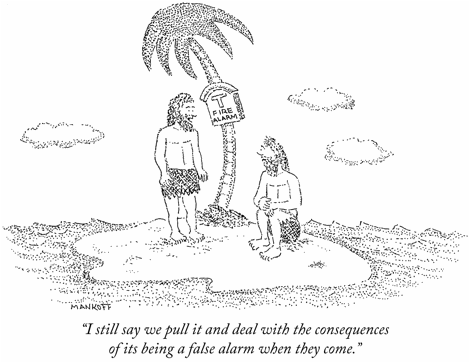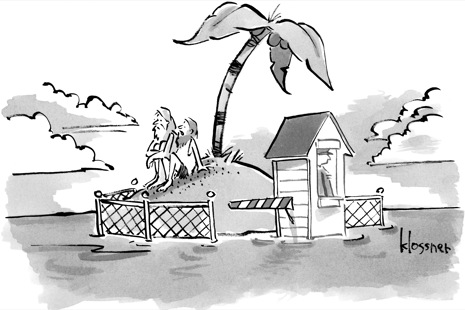Guest blogger Deirdre Barrett is a psychologist who researches dreams and sleep — and explores how dreams can be used to unlock waking-world problems. In this post, she looks at the New Yorker Cartoon Caption Contest, which recently featured a cartoon involving what might be a TED speaker’s worst nightmare … It started when, over on New Yorker cartoon editor Bob Mankoff’s blog, she threw out a challenge: Can you (literally) dream up a great caption? We asked for more:
The New Yorker Cartoon Caption Contest targeted TED recently. In early May, the image (supplied by cartoonist Harry Bliss) to be captioned was this:
©Harry Bliss/New Yorker Collection 2012
While The New Yorker hasn’t announced the finalists yet for contest #336 (finalists will appear online June 11), the entry posted by TED speaker Roger Ebert on his own blog gives a taste of what to expect:
I have a blog post of my own over at the New Yorker Cartoon Desk this week challenging readers to dream up–literally–captions for this week’s contest. I want to tell TED readers a bit about using dreams for cartooning and then send you over there to target them!
I’ve spent more than a decade researching dreams and creativity. But a year after my book, The Committee of Sleep, came out describing art, fiction, scientific inventions arriving in dreams, Bob Mankoff, The New Yorker’s cartoon editor, published The Naked Cartoonist. It contained the example below example–straight from a dream, and a fascinating description of how cartoons can originate in dreams. I realized this was one area of nocturnal creativity I hadn’t covered at all. (More on other forms of dream creativity can be found in my talk at TEDxKnoxville.)
©Robert Mankoff/The New Yorker Collection 2012
There are not all that many funny dreams, but at least three elements general to dream creativity can benefit cartooning:
1. Puns: language use drops in dreams, but the sound of words plays a larger role relative to meaning,
2. The emergence of forbidden impulses: the sex and aggression that escape sleep’s indolent censor are fuel for humor, and
3. Bizarre juxtapositions: what our dreaming mind fails to label as “not making sense” will strike our waking sensibilities as funny.
Freud wrote in The Interpretation of Dreams of “visual representation”: the tendency of a verbal phrase to be represented by an image. Of Freud’s many punlike examples, the only one robust in a translation from German to English featured a sexual encounter in a car interpreted as “autoeroticism.” Many of the amusing dream images I’ve encountered are literalizations of idioms — a family’s “black sheep,” an ambivalent dreamer “straddling the fence,” and another finding herself and her husband “on the rocks.” A century ago, Winsor McKay’s famous cartoon strips, “Dreams of the Rarebit Fiend” (so named as the cheesy dish was said to produce weird dreams), illustrated idioms showing up in dreams — as in this “Rarebit . . “ frame of a husband ending up “in the dog house.”
A second source of humor — the covert expression of forbidden impulses, whether sexual, hostile, or regressively dependent — is represented by cartoonists in the “dream bubble.” Sam Cobean’s captionless 1940s New Yorker cartoons are often credited as the first dream bubbles. While some of these represented daydreams, others did refer to nighttime dreams, such the one below:
©Sam Cobean/The New Yorker Collection 2012
The third element in dreams that strike our waking mind as funny — the bizarre juxtaposition of incongruous elements — inspired graphic artist Jesse Reklaw to produce two graphic novels that portray the dreams of other people, as they describe them. The comic potential of these are obvious in a few of the chapter headings from his book The Night of Your Life:
-I was in bed with a monkey doing the newspaper crosswords
-I accidentally got my boyfriend pregnant
-I took a bath in melted butter and forgot to dry off
This same element of bizarre juxtaposition is at the core of the humor in this cartoon by New Yorker cartoonist Joe Dator, who says: “This cartoon appeared whole in my dream. I woke up, made a quick sketch, and went back to sleep.”
 ©Joe Dator/ The New Yorker Collection 2012
©Joe Dator/ The New Yorker Collection 2012
Bob Mankoff points out that dreams can also begin cartoons: presenting a bizarre image that intrigues the waking cartoonist enough to create captions tying the incongruities together and completing the joke. He describes dreaming simply the visual image for the cartoon below–a bizarrely placed fire alarm. The image is somewhat amusing by itself, already tied into cartooning by the standard premise of the two castaways and the palm tree, but it became a fully formed cartoon only after Bob’s waking mind came up with the utterance linking the bizarre combination.
©Robert Mankoff/TheNew Yorker Collection 2012
This genre of incongruous juxtapositions has probably reached its apex in the New Yorker’s Cartoon Caption Contest. Bob suggests that the image-creation part of that process is what dreams do best, and I think that is likely. The same neurological quirk that makes our dreaming minds creative — our restrained prefrontal cortex — also means that we don’t recognize as easily that such juxtapositions need explaining. The prefrontal area is also engaged when appreciating humor, so we may not “get the joke” as easily while dreaming. However, as the “hair” cartoon and pun examples illustrate, dreams certainly can generate funny phrasing.
In my research, I’ve found that people are especially likely to dream solutions to any problem they “incubate,” or think about at bedtime and ask their dreaming mind to target. I’ve worked with scientists and artists seeking practical help from their dreams and with college students trying to solve brainteasers or just their own homework — and a significant percentage of each have made breakthroughs after incubating the problem at bedtime.
For the current New Yorker Caption Contest, Bob’s letting me challenge readers to dream their captions. Below are my standard dream incubation instructions, modified slightly to apply to the contest.
1) Place the cartoon to be captioned by your bed.
2) Review the cartoon image for a few minutes just before going to bed.
3) Once in bed, visualize the cartoon image in your mind’s eye.
4) Tell yourself you want to dream a caption just as you are drifting off to sleep.
5) Keeping a pen and paper–perhaps also a flashlight or pen with a lit tip–on the night table.
6) Upon awakening, lie quietly before getting out of bed. Note whether there is any trace of a recalled dream and invite more of the dream to return if possible. Write it down.
Here’s the image for this week’s Caption Contest:
©John Klossner/The New Yorker Collection 2012
In order for The New Yorker to collect all the dreamed captions most efficiently, please precede your caption entry with “#dream.” Entries are due June 10.
And if you return to that same Caption Contest link in a few days and scroll down, the finalists for the TED garterbelt cartoon will be posted and you can vote for your favorite caption.







Comments (6)
Pingback: How to dream up a New Yorker cartoon caption « Owen’s Meanderings